BIO 120 Adaptation and Biodiversity UofT: Test 1
1/99
There's no tags or description
Looks like no tags are added yet.
Name | Mastery | Learn | Test | Matching | Spaced |
|---|
No study sessions yet.
100 Terms
Theory of Evolution
1 - all living things change over times
2- adaptations have arisen through NATURAL SELECTION
Important Conclusions about Evolution
- organisms on earth have changed
- changes are gradual NOT instantaneous
- lineages split by speciation = biodiversity
- all species have common ancestor
- adaptation result from NATURAL SELECTION
Biodiversity
the variety of life in the world or in a particular habitat or ecosystem.
Adaptation
A trait that helps an organism survive and reproduce (noun)
Evolutionary process leading to maintenance of such trait (verb)
Evolutionary History (Patterns)
Study of the history of life forms on Earth - determining evolutionary relationships of organisms and pattern in evolution
Evolutionary Mechanisms (Processes)
Determining processes responsible for evolutionary change (natural selection)
- identifying the forces of evolution (genetic drift, mutation, migration)
Macroevolution vs. Microevolution
macro: evolution above the species level or leading to the formation of new species
micro: the changes in allele frequencies within populations
William Paley - Natural Theology
Argument from Design: because there is a design there must be a designer (watch anaology)
Jean Baptiste de Lamarck (1809)
-Suggested that life had been created long ago in a simple state, and had been gradually improving becoming more complex (Great Chain of Being)
-He proposed a specific mechanism for how this change occurs: the inheritance of acquired characteristics.
-Lamarck thus suggested that species change over time and that the environment was a factor in this change.
August Weismann (1834-1914)
-Proved Lamarck was incorrect because his theory stated that traits were inherited my somatic cells
- Weismann proved that inheritance only work through the gametes
- Mice experiment
Gradualism (Charles Lyell)
"Principles of Geology" - argued uniformitairiasim - change happens gradually
Darwins Conclusions:
-we live in a dynamic world
- change is gradual
Struggle for Existence (Thomas Malthus)
"An Essay of the Principle of Population": points out that organisms if unchecked should grow exponentially but resources shouldn't = struggle for existance
Darwins Conclusions:
- variation is everywhere, only favourable will survive.
Darwin's Mechanism of Natural Selection
1. Variation: individual variation in a population
2. Heredity: offspring resemble parents
3. Differential Fitness: some forms of variation will be more successful at surviving and reproducing than others
Important Elements of Natural Selection
1. evolution occurs at a population level (inidividuals don't evolve - lamaracks belief)
2. Variation is not directed by the environment, its determined by environment
3. most fit depends on the environment at that time
4. "Variation of the Fittest: Evolution works w/ available variation not always achieving perfection
Evidence from geology
- fossils - transition fossils link relatives
- earth is old = lots of biological evidence
Homology
Similarity in characteristics resulting from a shared ancestry
Vestigial Structures
remnant of a structure that may have had an important function in a species' ancestors, but has no clear function in the modern species
(goosebumps. appendix, ear muscles) - points to evolutionary past
Evidence from homology
- 500 genes are shared across all forms of life
- vestigial traits provide evidence of the evolutionary past
Evidence from Biogeography
- variation in traits due to location
- geographically isolated regions have unusual organisms
- geographically close organisms resemble one another
Evidence of Domestication
Ex. Teosinte and Corn: dramatic pheontypic variation becuase of breeding
- variation can be selected on -> dramatic changes
- artificial selection - human imposed selection
Genotype
genetic constitution of an organism (Ex. AaBB)
Phenotype
the set of observable characteristics of an individual resulting from the interaction of its genotype with the environment.
Genome
all of an organism's genetic material (DNA)
Mutation (source of genetic variation)
- stable change in the dna sequence
-occurs at a low rate
-can have different effects on fitness (negative., positive, neutral)
Types of Mutations
1- point mutation : ATGCAGT to ATCCAGT
2-insertion/deletion: ATGCAGT to ATGGCAGT
3-changes in repeat number : ATGATGATGATG to ATGATGATGATGATG
4-chromosomal rearrangements: TGCAGT to TGACGTA
Charactersitics of Mutations
- Inevitable phenomenon
- It is not directed toward an outcome
- Rate depends on the type of mutation and the environmental factors
Mutation Rates
Rate of new mutations is 16 every billion nucleotides each generation. Thats 96 per genome
Every base pair in the genome mutated 126 times over a generation
Independent Assortment
allows different combinations of parental chromosomes
Humans: 23 sets of chromosomes. 2^23 = 8.4 million different gamete combinations
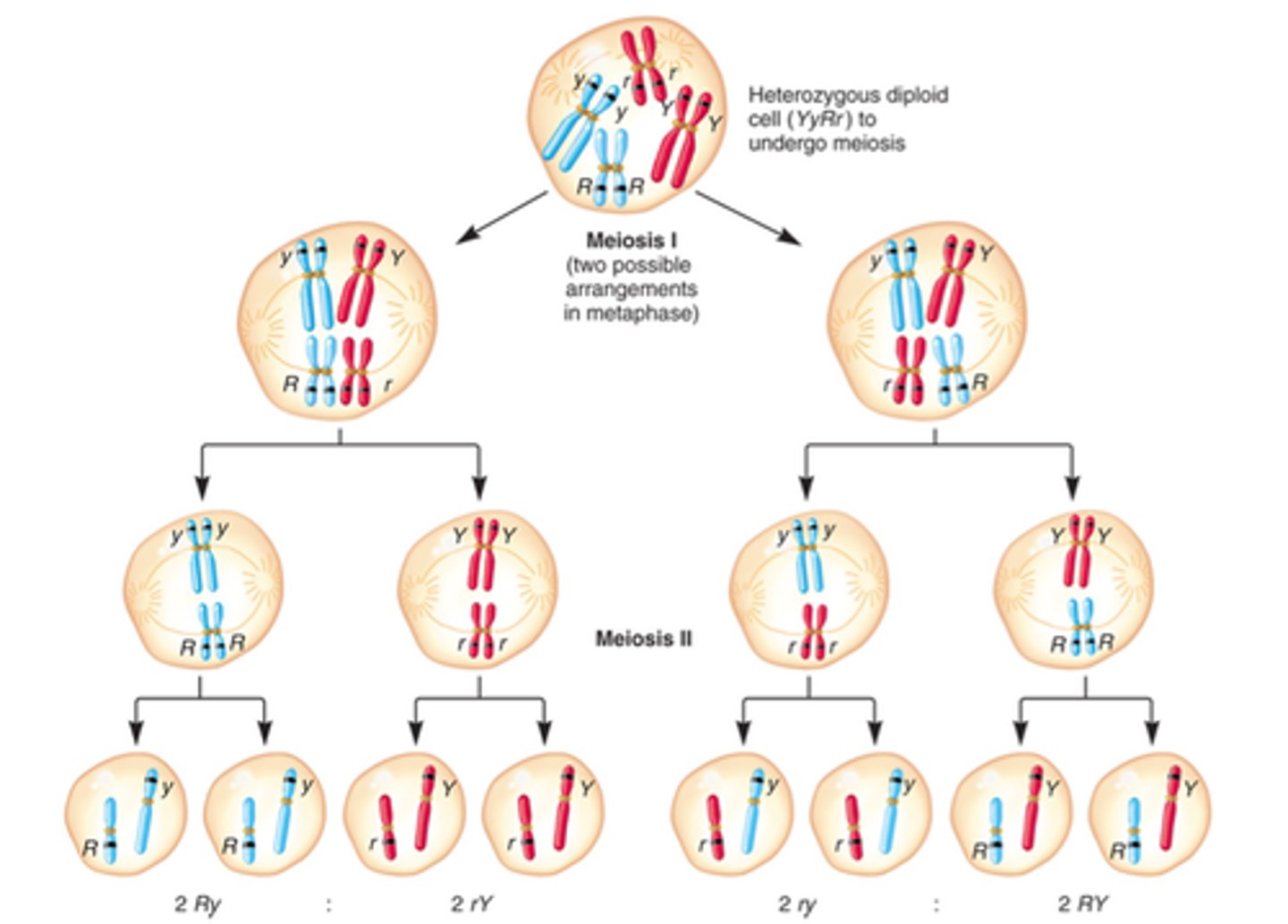
Recombination
the genetic process by which one chromosome breaks off and attaches to another chromosome during reproductive cell division
Heredity Before Mendel (Preformationism and Blending Inheritance)
Preformationism - one parent contributed to inheritance
Blending Inheritance: mom x dad = child
yellow x blue = green - no way to get parentyl phenotype no way for mutation to arise
Conclusions from Mendel's pea experiment
-inheritance is determined by genes
-each diploid carries two alleles of each gene (dominant/recessive)
-gametes fuse to make offspring (sperm/ovule/ pollen/ egg)
-offspring inherit one gamete from each parent at random
Forces that influence genetic variation: Mutation
errors during replication + increases genetic variation
Forces that influence genetic variation: Recombinations
creates new combinations of mutations + increases genetic variation
Forces that influence genetic variation: genetic drift
- Random sampling affects every generation
- More important for populations that are smallr
- decreases genetic variation
genetic drift
A change in the allele frequency of a population as a result of chance events rather than natural selection
- decreases genetic diversity
- VERY POWERFUL IN SMALL POPULATIONS
Forces that influence genetic variation: Natural Selection (Purifying)
- Mutations that reduce fitness are removed by natural selection
- Decreases genetic variation in populations
Forces that influence genetic variation: Natural Selection (Positive)
- Mutations that increase fitness will eventually become fixed in a population
- Decreases genetic variation in populations
Fixation
Occurs when a polymorphic locus becomes monomorphic due to the loss of all but one allele
Forces that influence genetic variation: Natural Selection (Favouring Diversity)
Natural selection can act to maintain diversity over the long term (e.g., heterozygote advantage)
-Increases (or retains) genetic variation in populations
Migration
Influences the structuring of divesity over large spactial scale
- decreases differences between populations
- increases genetic diversity in population
Gene Flow
movement of alleles from one population to another
- most gene flow occurs over short distances
-
Heterozygosity
having different alleles at a gene locus
have both alleles (aaAA)
Polymorphism
The coexistence of two or more distinct forms in the same population.
Measuring Genetic Variation
1-Heterozygosity: fractions of individuals who are heterozygous
2- polymorphism: proportion of genes that have two or more alleles in the population
Mutation-selection balance
less fit types reintroduced by mutation
followed by selection acting to remove them
Selection maintaining variation
- Heterozygote advantage
- Frequency‐dependent selection
- Fitness varies in space or time
- Umbrella term "balancing selection"
Classical School (Maintaining Variation)
- Morgan, Muller
Low heterozygosity
- Low polymorphism
- Wild type is 'normal' genotype
- Selection typically negative
Balance School (Maintaining Variation)
- Ford, Dobzhansky
- High diversity = high H and P
- selection favours diversity
Genetic Markers
Morphological - snail colour polymorphism
Cytological - chromosome inversions
Richard Lewontin and the Electrophoresis Revolution
Allozymes: different allelic forms of the same protein
- provided a way to ask "what portion of genes are variable (P&H)"
Monomorphic gene
monomorphic gene: no variation in a population
Monomorphic genes in electrophoresis have same level (in the way they spread)
Polymorphic gene
Traits that have two or more variants (human eye)
Polymorphic genes in electrophoresis have varying levels
The Neutral Theory (Genetic varitation)
Motoo Kimura
- Negative selection rapidly eliminates detrimental mutations
- Positive selection rapidly fixes beneficial mutations
- The only mutations left to create genetic variation are selectively neutral
DNA Variation in Maize vs. Teosinte
A consequence of population bottleneck(s) during domestication (founder event)

Human Genetic Variation
- Humans show a loss of genetic variation with increasing distance from East Africa
- Reflects founder events as humans migrated from source population
Founder Event
New population is established from a small number of individuals drawn from a large ancestral population
- colonizing groups contains only limited diversity compared to the source population
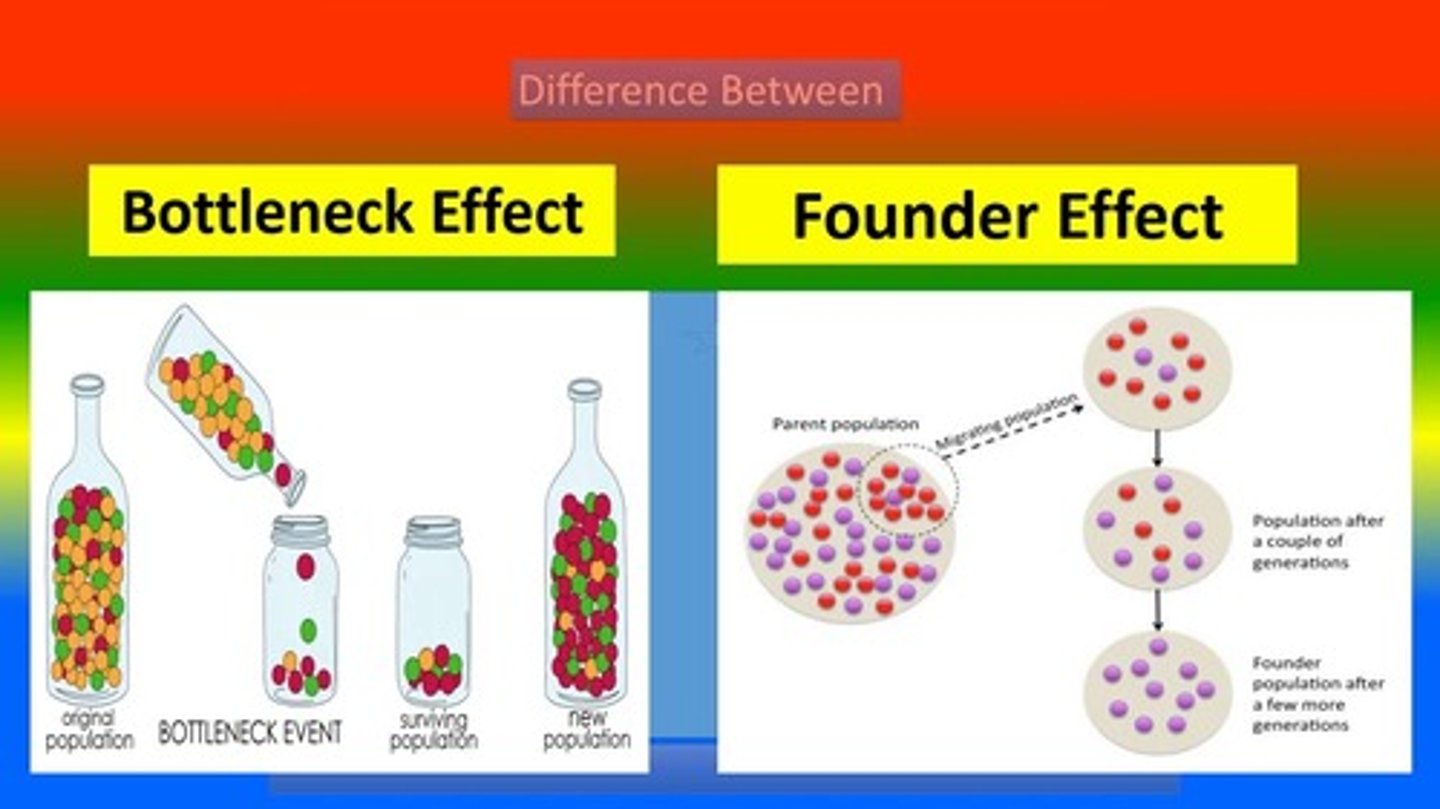
Sexual Reproduction
A reproductive process that involves two parents that combine their genetic material (fusion of gametes) to produce a new organism, which differs from both parents
Asexual Reproduction
1 parent, no meiotic reductive division, organisms are clones of parents
Dioecious
2 sexes - one has big and one has small gamete Having male and female reproductive organs in separate plants or animals
Hermaphrodite
- an organism that has both male and female reproductive organs (note the same as asexual reproduction)
- produce both types of gametes (egg and sperm)
cross-fertilization
The fusion of sperm and egg derived from two different individuals.
self-fertilization
bring egg and sperm together
mixing of different gametes
Partheognesis
asexual reproduction in which embryo develops from an egg without fertilization
Clonal Propagation
Asexual reproduction not involving an egg
Facultatively Sexual
can reproduce sexually or asexually
Two-Fold Cost of Meiosis (Costs of Sex)
Sexual females only contribute 50% of her gene copies to next gen, the transmission bias favours asexual females
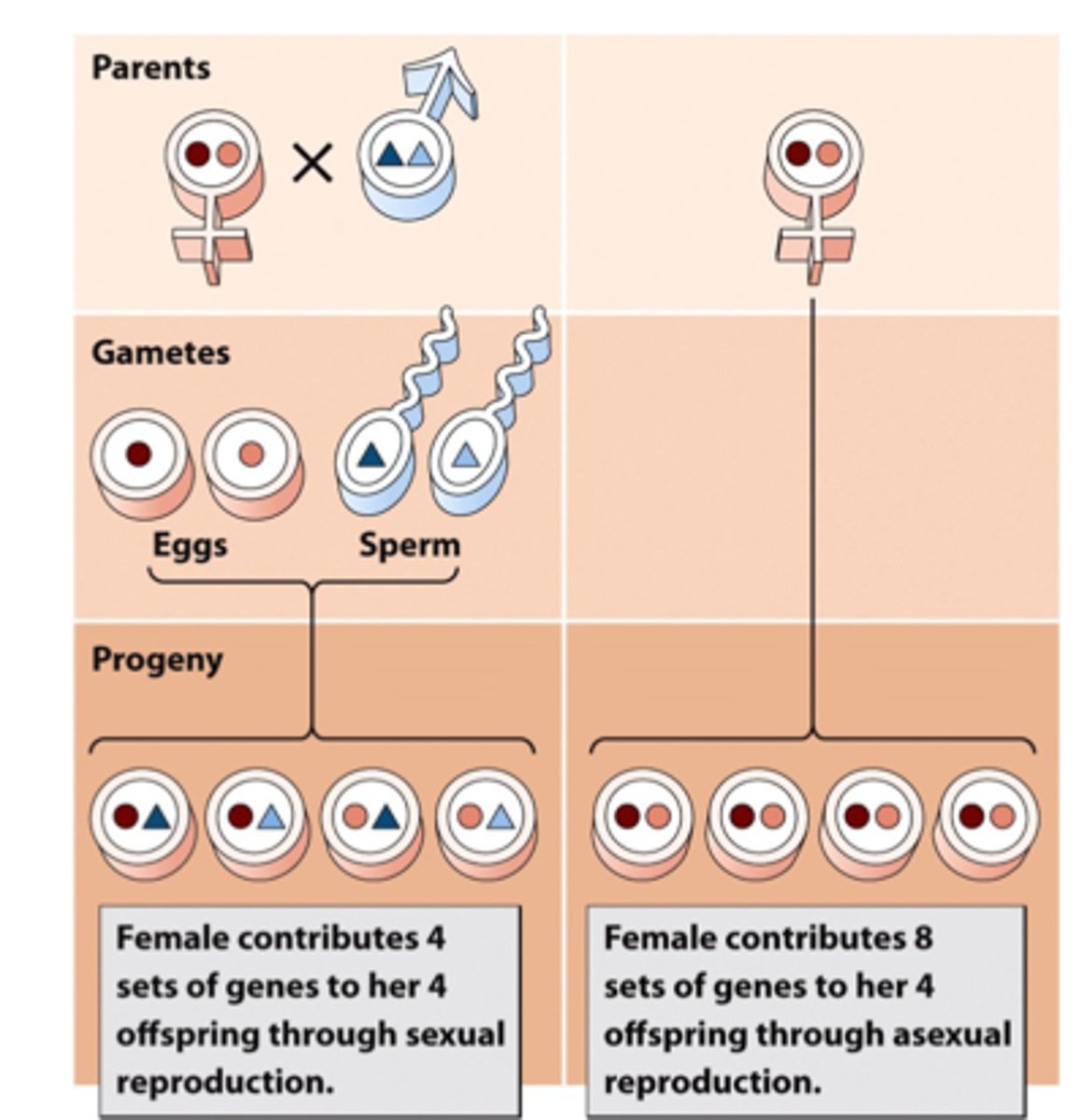
Favourable Combinations of Alleles (Costs of Sex)
Sexual reproduction can continually re-create unfavourable combinations of alleles
More costs of sex
- time and energy
- risk of predation and infection
- cost of producing males
Favourable Combination of Mutations (benefits of sex)
help form favourable combinations faster
Elimination of harmful mutations (Benefits of sex)
independent assortment and recombination will get rid of harmful muations
"Lottery Models" (Benefits of Sex)
Benefits of genetic variation in variable/unpredictable environments
- Spatially heterogeneous environments (diversity allows offspring to do well) = 'tangled bank hypothesis'
- Temporally heterogeneous environments = 'Red Queen hypothesis' (the more things change, the more they stay the same"
Asexual Reproduction Cons and Ideas
- asexual lineages are towards the tips of phylogeny
- asexual organisms tend to have more "premature" stop codons = dysfunctional proteins
- evolve quickly in a bad way
- Sex declined in homogenous environments and persists in higher level with heterogeneity
Outbreeding
Mates are less closely related than random
Inbreeding
Mates are more closely related than random
outcrossing vs selfing
Outcrossing: Mating with someone else
- Either by outbreeding or inbreeding
- Fusion of gametes from 2 parent: Gametes derive from meiotic reductive division
Selfing:
Mating with yourself
- Most extreme form of inbreeding (But NOT asexual reproduction)
- Fusion of gametes from 1 parento Gametes derive from meiotic reductive division
Reasons of Inbreeding
- small populations, no other option
- local population enhances mating among each other
- Hermaphroditic organisms have more potential for inbreeding
Inbreeding Avoidance Plants
- time offset
- self-incompatibility
Inbreeding Avoidance Animals
- dispersal by one sex = one sex goes far
- delayed maturation
- extra pair copulation = cheating
- Kin recognition and avoidance
Effects of Inbreeding
- change in genotype frequencies: increase homozygosity and decrease in H
- does not change allele frequency = does not change polymorphism
Inbreeding Depression
reduction in fitness of inbred offspring compared to outcrossed offspring = lower viability and fertility
- can cause change in allele frequencies
Inbreeding Consequences
-genotypic frequencies altered (homozygosity of recessive alleles)
-allelic frequencies unchanged
-heterozygosity reduced by 50% per generation
-homozygosity for deleterious alleles gives inbreeding depression
Why inbreed?
selfing varient has a transmission advantage
- takes less ressources and you get one more gene copy then an outcrosser
Slefing over short term
If conditions are favourable selfing can spread via natural selection
- Lack of "reproductive assurance" due to rarity of pollinators or mates
- Transmission advantage from self + exported pollen
- Low inbreeding depression
BUT harmful effects of inbreeding depression encourage outcrossing
Slefing over long term
- low diversity and inefficient seletion
- higher extinction rates = reduced genetic diversity
Fitness
Genetic contribution of individuals to next generation, relative to other individuals, as aresult of differences in viability and fertility
Selective advantage
The amount by which some individuals of a given genotype are better adapted to a given environment
- Reflects relative differences in fitness
Artifical selection
selection by humans towards a goalNa
Natural Selection
Selection by abiotic and biotic environment
- No "goal"
- Affects all organisms (including humans)
Modes of Selection
Positive, Negative, Selection to maintain variation
Stabilizing Selction
Favours average traits (progeny will have steeper average traits)
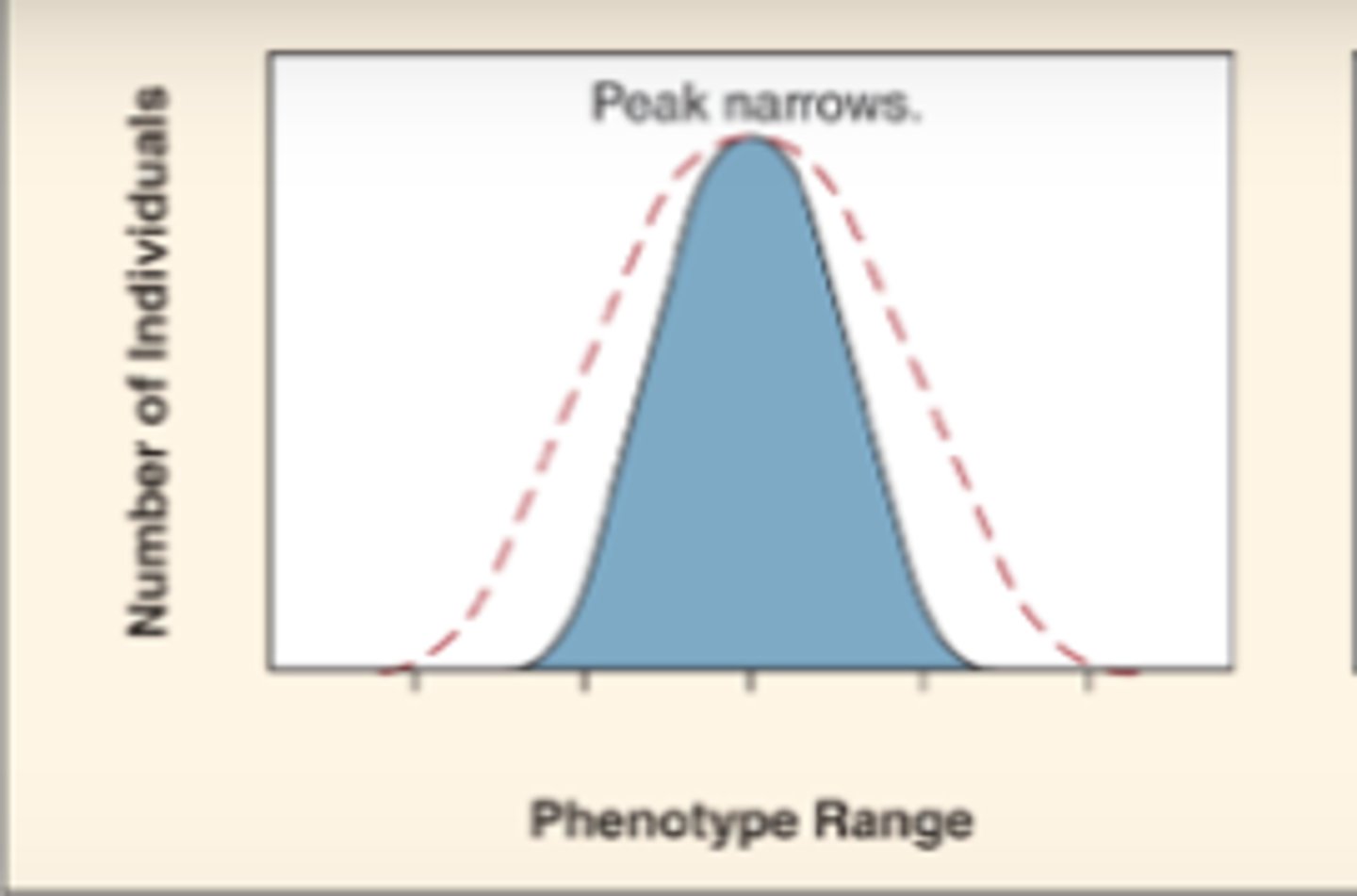
Directional Selection
Favours one extreme - the graph doesn't change size, it just moved over
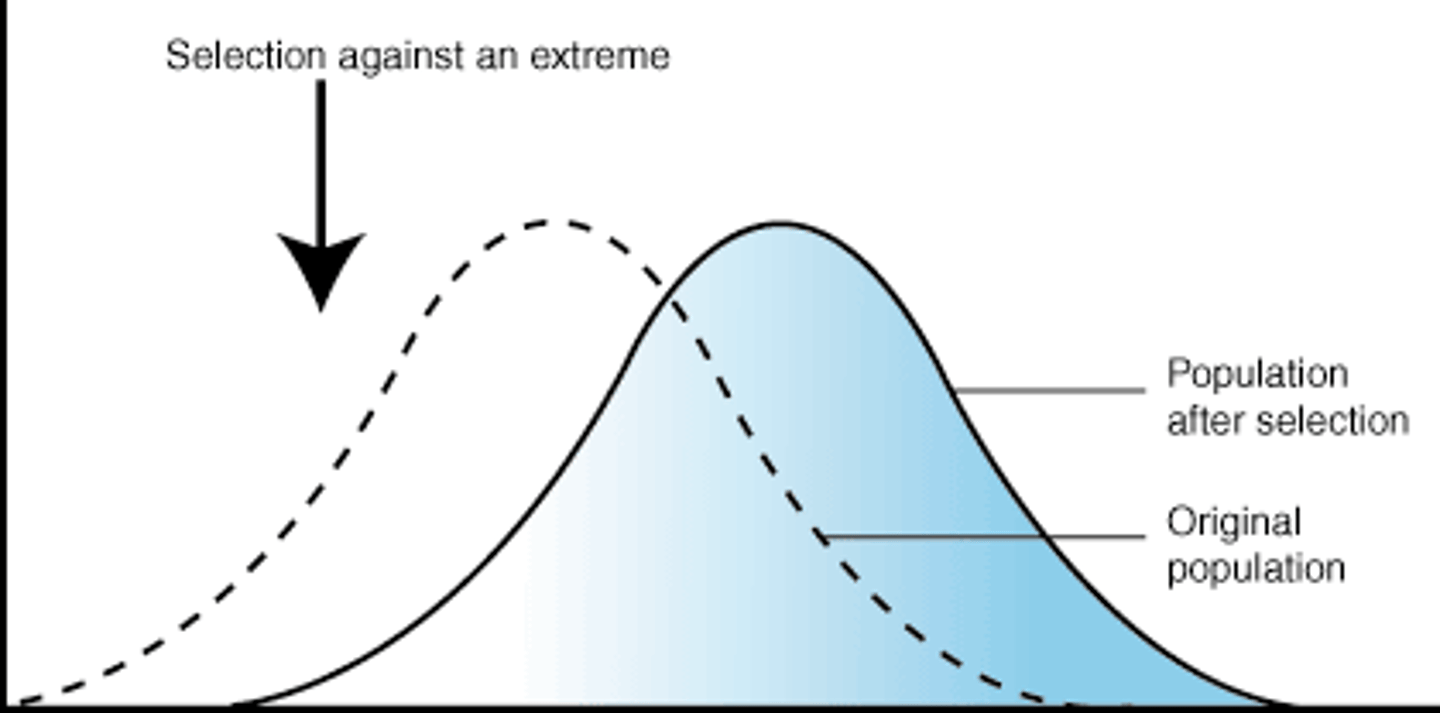
Disruptive Selection
Favours both extremes - leads to trait divergence (some gases causes a reduction in gene flow)
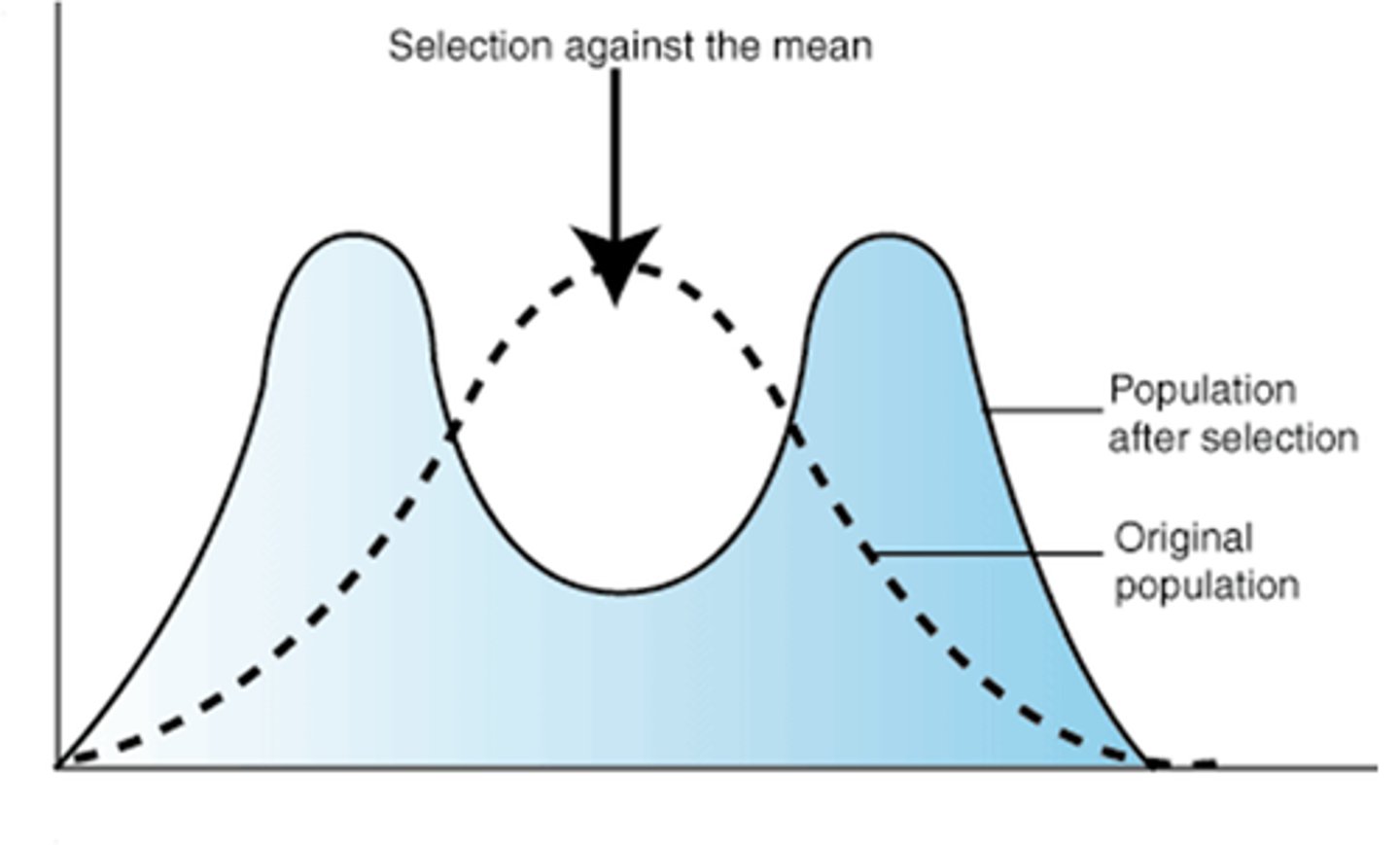
The Peppered Moth and Industrial Melanism
increased frequency of dark-colored (melanic) peppered moths during the Industrial Revolution in England, as soot-darkened trees favored their camouflage and survival over lighter-colored moths, illustrating natural selection (directional).
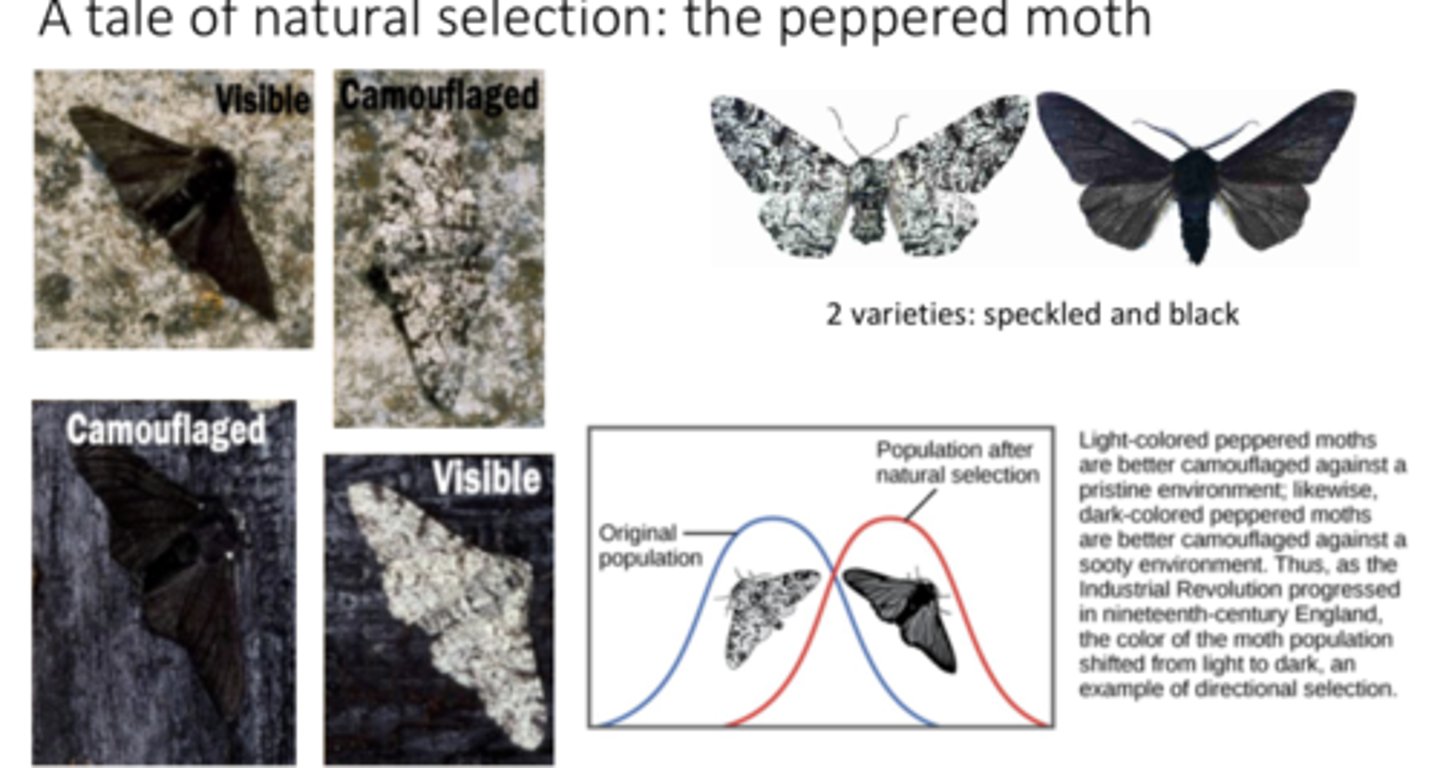
Heavy Metal Tolerance in Plants
Heavy metal tolerance in plants near mines evolved as a result of natural selection, where only tolerant individuals survived the toxic soil
No gene flow occurs between the plants in pastures and those by the mine because of time-offset and to avoid the mine plants to loose their resistance
G6PD Deficiency in Humans
- causes severe anemia but protects against malaria
- when malaria is absent there is selection against anemia
- when malaria present there is a selection for malaria resistance
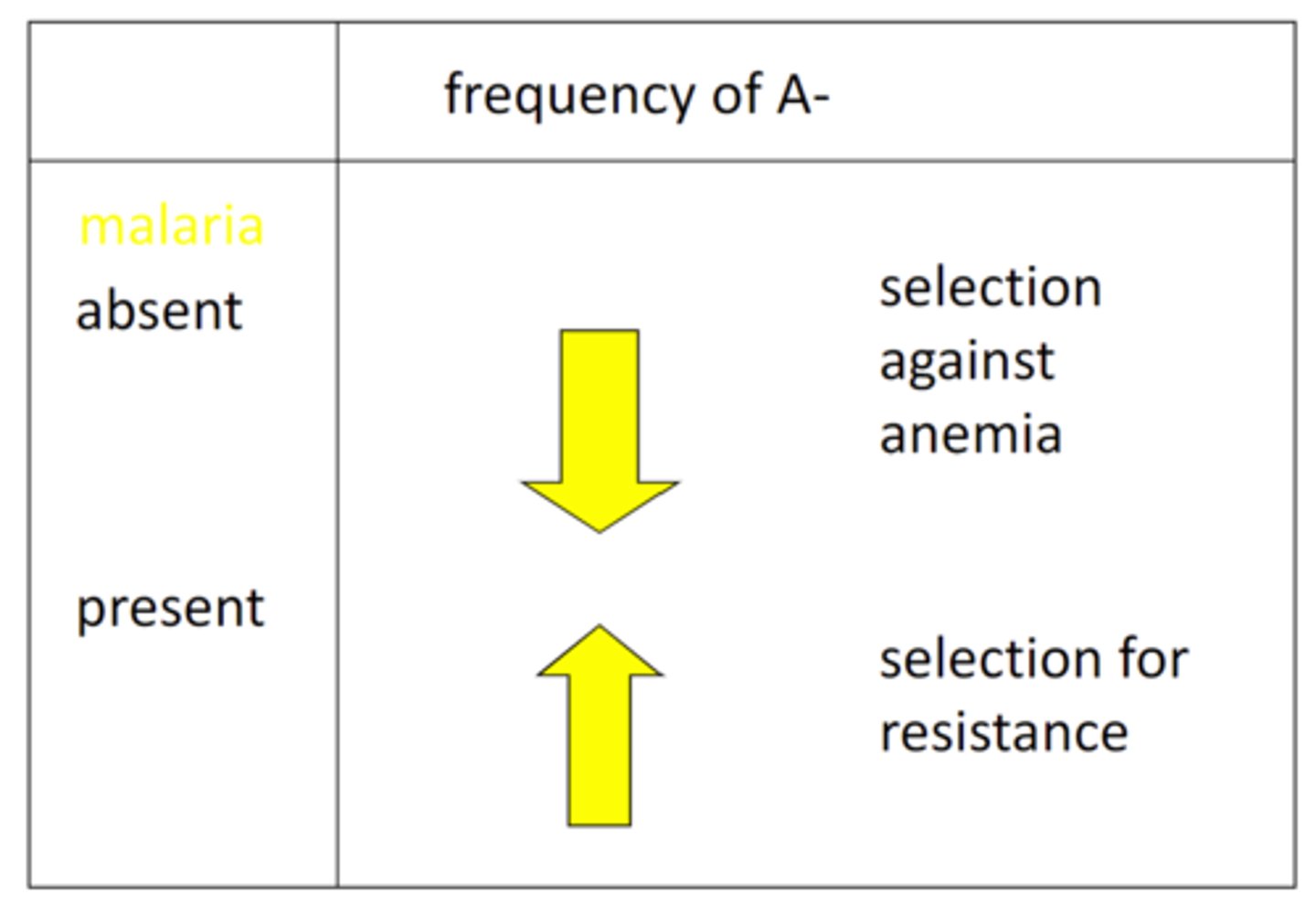
Selective sweep
occurs when selection causes a new mutation to increase infrequency so quickly that nearby alleles "hitchhike" and also increase in frequency
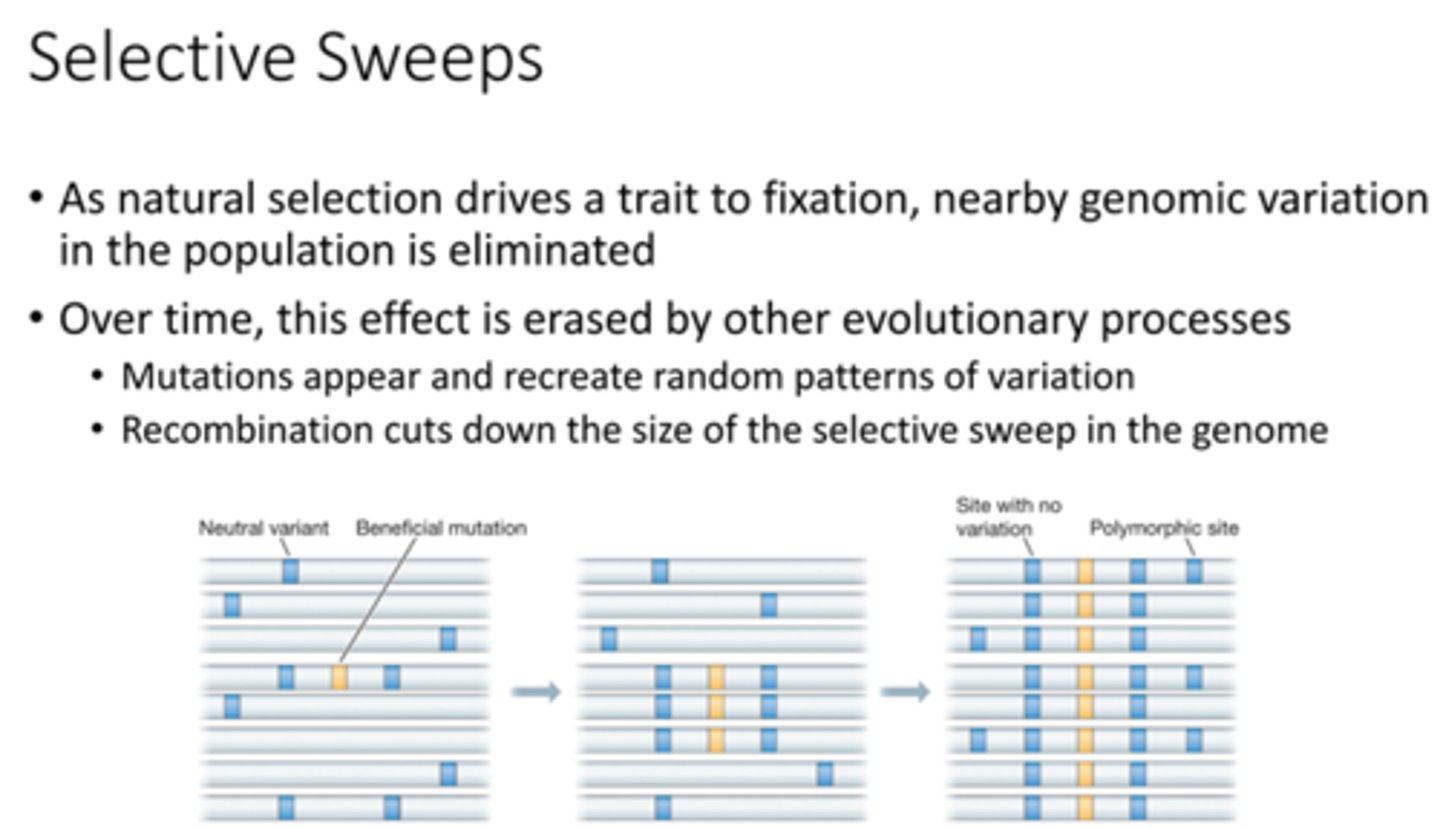
genetic marker
a gene used to study biological process
discrete vs quantitive trait
discrete traits are characteristics with distinct categories (e.g., blood type or flower color), typically controlled by one or a few genes,
quantitative traits vary along a continuous spectrum (e.g., height or weight) and are influenced by multiple genes and environmental factors.
Richard Lenski
founder of experimental evolution
How to study Adaptation
1) test for corelation for alleles (analayze genomic diveristy
2) look for distincitive paattern targeted selction
3) experminetal